1:72 TS-11 Iskra bis DF "Deluxe Set" review
Another debut in the field of 1:72 injection molded aircraft kits. This time it's Arma Hobby from Poland, so far known as a manufacturer of a resin accessories and models of somewhat obscure subjects. The newest kit still tackles a rather niche topic, but it's a standard long run plastic model. Double set with additional resin and photo-etched details hits the stores recently and hopefully will replace the old ZTS Plastyk kits, which clearly overstay its welcome. But is the Arma Hobby release any good? Let's see.
Soltyk's Spark
Iskra (Polish for Spark) was conceived in a response to a Polish Air Force requirement for a jet trainer. Work started in 1957 with the leadership of Tadeusz Sołtyk (hence the "TS"), who just designed the piston-engine TS-8 Bies trainer.

Maiden flight of the first Polish jet airplane happened at February 5th, 1960. Further tests validated the design and the mass production begun in 1962 at WSK Mielec plant. Initially manufactured aircrafts weren't all-Polish design however. They were equipped with WSK HO-10 engine, which was a copy of British Armstrong Siddeley Viper 8. Polish designed jet engine WSK SO-1 was introduced to production in 1966.
First version manufactured, designated TS-11 Iskra bis A, was dedicated to training missions. Iskra bis B, with enhanced armament, introduced the expanded attack capabilities. Next was Iskra bis C- single seat reconnaissance version, with only 5 machines produced (later converted to standard two-seaters). There was also an attempt to design a single-seat attack version (TS-11 Iskra BR 200) in 1972, but only one prototype was made and project was cancelled. TS-11 Iskra bis D from 1973 was improved training and attack version, and Iskra bis DF was subsequent reconnaissance-trainer. The latter was also modified to meet the Polish Navy requirements, and in small number (6 aircrafts) entered the naval service as an Iskra R Novax.
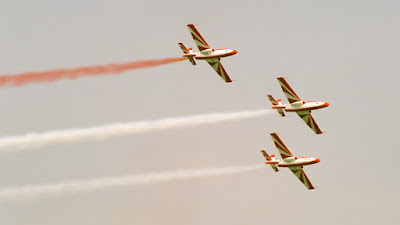
In 1961 TS-11 competed in the contest for a standard jet trainer of a Warsaw Pact, but lost to the Czechoslovak Aero L-29 Delfin. Some say that this was a political decision, which didn't reflect real value of Sołtyk's design. Poland became the only Warsaw pact country which use the Iskras and inevitably the plane wasn't an export hit. Only one other country bought it- India, to where 50 TS-11 Iskra bis D was exported in 1975.
Well over four hundred TS-11 of different versions were manufactured until 1987, when the production ceased. Used both in Polish Air Force and Navy made significant impact in the Polish aviation history and are one of the most recognizable aircrafts in its homeland. But probably the most notable role of a TS-11 is the aerobatic one. From 1969 it is a standard aircraft of Polish Air Force aerobatic team "White-Red Sparks" and still can be seen at various shows.
1:72 Background
It's not a surprise that such iconic (at least for Poles) aircraft was in a model kit form available for years. If I'm correct, the first TS-11 plastic miniature (although very simplified) was released in 1960' by Ruch. However the most known and still widely available is the ZTS Plastyk kit. Re-boxed many times, also by others manufacturers like Aeroplast and Mastercraft, was (and still somewhat is) a very popular model despite its shortcomings. Don't get me wrong- it was a pretty nice kit, when it was released (in the nineties). But it's not up to a modern standards and years of production clearly made an impact on its overall quality. Therefore Arma Hobby announcement of a new plastic Iskra scale model in 1:72 was a nice surprise and the kit was eagerly awaited.
Deluxe Set
There were three different boxing promised by AH. First they cunningly released "Deluxe Set", similar in concept to Eduard's "Dual Combo" editions. Two models with addition of resins, photo-etched parts and masks. Single kits ("Basic"- only with plastic sprues and decals; "Expert"- with additional PE and masks) will be available later, for more patient modellers.
For now we have only "Deluxe Set". Packed in sturdy, top opening box with quite a nice box-art. I personally prefer traditional drawings instead of photographs, but this time I won't complain, because overall effects is really esthetically pleasing.
Box content
Inside- two light grey plastic sprues, a transparent one, two photo-etched details sheets, masks, resin seats and wheels. Times two of course. Other than that- decals, assembly instruction and short thank you letter from the manufacturer. Nice.
In Close-Up
Transparent elements looks pretty nice- clear and molded without any flaws. Little bit thick maybe, but completely acceptable. However close inspection of the gray plastic sprues raises somewhat mixed feelings. Overall parts look good, but here and there you find some little flaws that give almost short-run like impression of the molding. For example- close surroundings of a certain panel lines on a fuselage halves clearly need some special attention.
Oh yes, panel lines. Somewhat hot topic these days. Yeah, they are kind of Airfix-like in this case, but not even close to Spitfie Mk.I level. No need to despair in my opinion.
There's a lot of ejection pins marks on the parts, but mostly in areas where you don't need to bother. Mostly, not always (e.g. flaps). Cockpit interior is pretty OK and the PE and resin parts will of course improve that area quite a bit.
Which is welcomed, especially in case of the instrument panels, which are irreversibly destroyed by sinkholes. Those particular molding flaws are sadly present on couple of other parts too. Some in places easy to deal with, other (e.g. one inside of the engine exhaust)- not so much.
Rest of the details looks rather nice. Well, except of the rocket launchers- these doesn't make a particularity good first impression, at least at me.
Accesories
Besides the plastic, "Deluxe Set" contains some additional details, which are also sold separately. Masks for the canopy and wheels, which looks OK, but can be properly judge only when used. Resin replacements for plastic seats and main wheels. The latter are somewhat peculiar choice, cause the plastic one aren't so bad either and in the finished model wouldn't be exposed very much. I would rather see resin rocket launchers than this, but I don't complain.
Two sets of photo etched details. First, oddly named "interior", with essential elements- mostly cockpit interior plus air intakes covers. Second, "exterior", with additional details like air brakes or front wheel bay (yes, there is no plastic element for that on the sprues).
Decals
Sheet contains markings for six different aircrafts: two camouflaged, two in natural metal finish and two in special shark-themed schemes. There are also two set of stencils provided. One for camouflaged TS-11s and one for NMF machines (aircraft in special paint schemes didn't carry any stencils).
Overall print quality is pretty nice, without any color displacement or any similar flaws. Some modellers reported couple of minor errors in certain emblems, but it is some really heavy nitpicking.
Painting options
As was said earlier, kit contains markings for six different aircrafts. Five TS-11 from Polish Air Force and one belonging to Polish Navy.
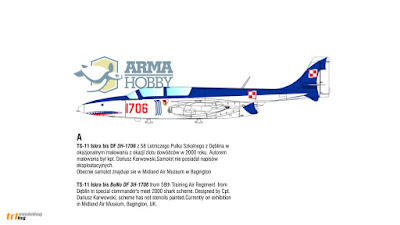

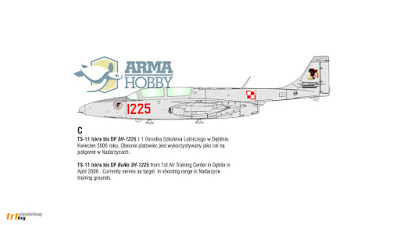
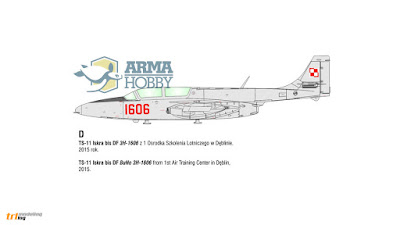
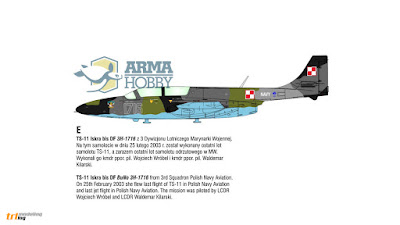

Each of the schemes is presented in instruction on 4-way color profiles with decals arrangement showed. Recommended colors are given only as a FS numbers, which is a little disappointing. However you can find extended color table on Arma Hobby blog (link), where was published by one of the brand creators.
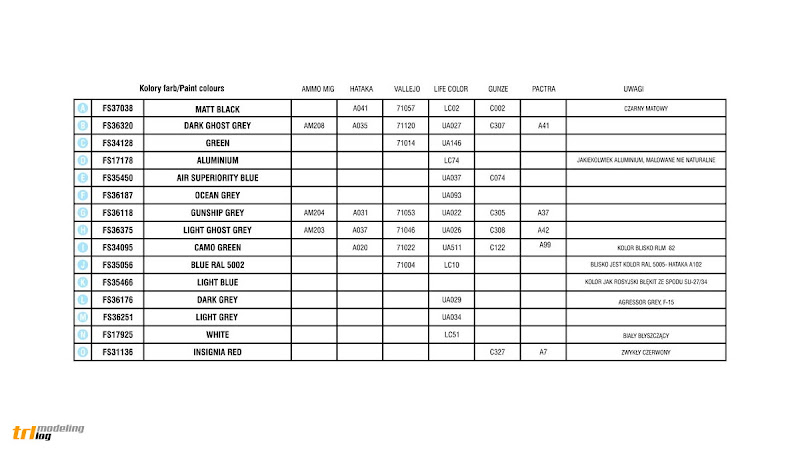
Instruction
Instruction manual is printed in color, all on thick paper. Completely unnecessary if you ask me, but whatever. Assembly diagrams made with traditional outlines of parts are clear and easy to read. My only objection is that the instruction doesn't show one straight-forward build with all of the accessories from set, but is divided in some blocks which causes the need to jump back and forth. Not a real issue, probably caused by unification between different kit versions, but some may find this distracting. Arma Hobby published the PDF version of the manual on its website (PDF 2.4MB) so you can judge for yourself. There is also second PDF available online (PDF 4.1MB), mentioned in the short thank you letter, which shows some small errors in panel lines overlooked in kit design. Nice to see a manufacturer which doesn't afraid to admit to some mistakes.
Summary
So here you have it- first plastic model from Arma Hobby. Is it a "great little kit"? Well, in my opinion- no. Numerous molding imperfections clearly reveals its maiden nature. Which is unfortunate, because without that flaws would be really nice. However it's still a solid kit, which simply need some more attention, and with added PE and resin parts can be probably turned into a very nice miniature of TS-11.
I hope that Arma Hobby will quickly overcome the problems with injection molding production and next plastic models will be better. Especially that they recently announced another interesting kit- PZL P.7 in 1:72 scale.
Credits
I would like to thank the author of the following photos used in the above review.
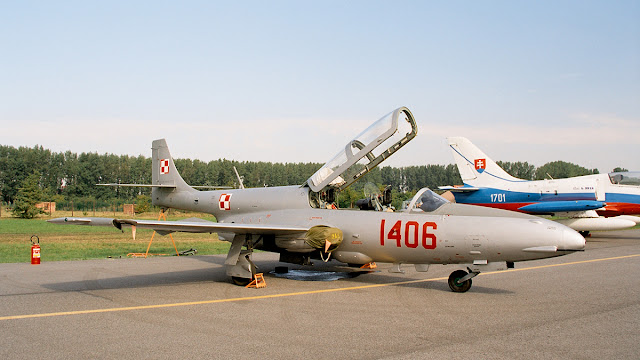 by Przemyslaw "Blueshade" Idzkiewicz (cc-by-sa 2.5 license)
by Przemyslaw "Blueshade" Idzkiewicz (cc-by-sa 2.5 license) by Przemyslaw "Blueshade" Idzkiewicz (cc-by-sa 2.5 license)
by Przemyslaw "Blueshade" Idzkiewicz (cc-by-sa 2.5 license)

